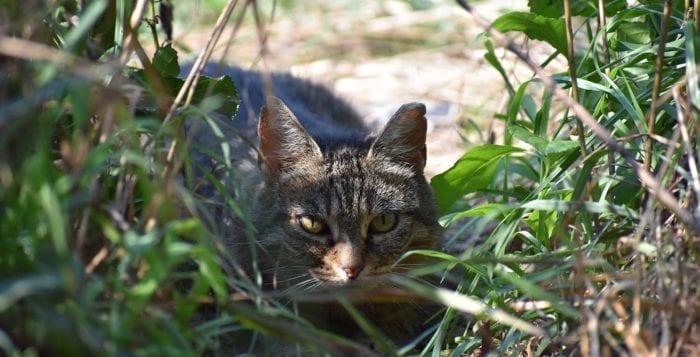Along a right-of-way in Mount Sinai, the exact location volunteers preferred not to publicize, a number of cats stalk through the cover of tall grass on silent paws. Upon hearing human sounds, they scatter deeper into the weeds.
“Babies, babies, momma’s here,” Miller Place resident Rita Miszuk called to the wild felines as she refilled water and food trays. She said she didn’t want to give away too many specifics of the location out of fear more cats will be dropped there and left in need of care.
Miszuk is the president of Volunteers for Animal Welfare Inc., a nonprofit that aids feral cat colonies across Long Island. Her group tries to infiltrate cat communities, taking the animals to places where they can be vaccinated, spayed and neutered, often on the organization’s own dime. Miszuk said she sometimes spends thousands of dollars to humanely control the number of wild cats roaming free.

“There were 50 here, but we’ve gotten them down to 11 — they’re all healthy and they’re all taken care of,” Miszuk said. “This is what typical rescuers do.”
They’re not her cats, in fact they’re nobody’s cats. They’re considered “feral,” but that word belies the terrorized nature of these animals left in the wild. They’re shy, they’re alone, and there are more and more every year.
Suffolk County Society for the Prevention of Cruelty to Animals Chief Roy Gross estimated, using the organization’s own metrics, approximately 322,000 cats live in Suffolk County, including both feral and domesticated cats. For every four people in the county, there is approximately one cat.
The number of rescue groups, along with the amount of trap, neuter and release programs that attempt to capture these animals, care for them and sterilize them before releasing them back into their original environment, has gone up of late. Still, Gross said the problem only continues to grow as cats continue to breed and people leave unneutered cats in homes as they move away.
“The population is out of control,” Gross said. “[Rescue groups] put a dent in them, but there are just so many cats out there.”
One female cat can give birth to three litters in a year with an average litter of five. Multiply that by their offspring and one cat can become 225 in a year. Erica Kutzing, vice president of Sound Beach-based Strong Island Animal Rescue League, suggested the problem is exacerbated by the warming climate. Where cats used to become pregnant only in the summer months, she said she is now seeing pregnant cats give birth as early as March or February as they get pregnant later in the year.
“A lot of people like to say, ‘It’s not my cat,’” Kutzing said. “It’s fine that it’s not your cat, it’s not our cat either; however, if we don’t fix the problem you’re going to have a lot more ‘not my cats’ on your property.”
A number of animal shelters exist across the North Shore, and many of them host TNR programs. Kent Animal Shelter in Calverton provides spaying and neutering for $50 per cat. Sometimes if the shelter is able to secure a grant, the price can drop to $20.
“A lot of people like to say, ‘It’s not my cat. It’s fine that it’s not your cat, it’s not our cat either; however, if we don’t fix the problem you’re going to have a lot more ‘not my cats’ on your property.”
— Erica Kutzing
Some shelters are expanding their TNR capabilities. In June, the Town of Smithtown accepted a grant to build a new TNR building at the Smithtown Animal Shelter that will expand the town’s capturing capacity, as representatives of the shelter said they estimated Smithtown hosts around 30 to 40 different cat colonies. The town plans to start construction after it receives the funds in 2019, according to Smithtown spokeswoman Nicole Garguilo.
David Ceely, the executive director of Little Shelter Animal Adoption Center, which is also the managing organization for the Town of Huntington Cat Shelter, said it offers residents free TNR services to deal with feral cat communities. Still, the problem is so large Little Shelter often relies on volunteers and community members to manage cat populations.
“We’re one shelter, so to go out there and take care of all of them physically we wouldn’t be able to do it,” Ceely said. “But thankfully there are people in the community who want to do the right thing, and we want to support that.”
Otherwise getting a cat spayed and neutered could cost up to hundreds of dollars per cat, depending on the animal shelter or veterinarian. It means doing TNR on an entire colony could create an incredibly restrictive cost barrier.
“We just did 24 cats in Stony Brook and the final price was about $1,400,” Kutzing said. “That came from our own funds.”
Frankie Floridia, the president of Strong Island Animal Rescue League, said small rescue groups are not large enough to combat the problem, and there is a need for community members to get involved with their own local feral cat communities.
“We get at least 20 calls a month, such as about kittens under a deck or cats with an upper respiratory infection,” Floridia said. “We handle what we can but we’re a small organization.”
Worse still is the proliferation of cats has made the population start to seem like an infestation or a blight. This mindset has fostered an environment in which some commit horrendous crimes against cats, including maiming and torturing the animals. All cats, not just domestic cats, are considered a “companion animal” by the state.
Harming them is a Class E felony punishable with a $5,000 fine and up to two years in jail. Taking a cat to another location is considered abandonment and is a misdemeanor punishable by one year in jail or a fine up to $1,000.

“There are people out there who are sadistic criminals who go out and find easy prey, generally the kittens,” Gross said. “We have had people in the past drive spikes through them, behead them, impale them, poison them — just horrible acts of animal cruelty. Some of those people are just sadistic, but in cases like poison some people just don’t like these cats roaming around on their property.”
Beyond acts of violence, many residents either don’t know what to do or don’t feel it’s their concern. If people do not interact with these community cats by either taking them to a TNR program or by feeding them, then either the cats numbers grow exponentially or they will start to die.
“Without these people who take care of the cat colonies, we would have cats starving to death,” Kutzing said. “There would just be cat bodies littered everywhere.”
Many groups and shelters like Strong Island or Little Shelter offer local residents opportunities to use their cages to trap the animals so they can later be spayed and neutered. Kutzing said if the cost prohibits a resident from acting on a cat population, they should try and get their neighbors involved and make it a community fund. After all, the community cat problem is a community issue.
“If everyone gets involved, this problem will be drastically cut,” she said.
Miszuk said while her group does what it can, she needs local businesses, residents and especially local government to step in and help, otherwise the problem will only get worse.
“This problem has been swept under the carpet,” Miszuk said. “We need support to say that we are legitimate first responders.”





